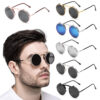
Sep 22, 2024 | Lifestyle
Understanding Polarized Sunglasses
Polarized sunglasses are designed to enhance visual comfort and provide protection against harmful rays, primarily by reducing glare from reflective surfaces. The science behind polarized lenses lies in their ability to filter light, specifically horizontally polarized light that causes glare. When sunlight hits a flat surface such as water, snow, or a road, it creates a blinding reflection that can obstruct vision. Polarized sunglasses contain a special chemical coating that helps block this glare, allowing for clearer and more comfortable vision.
One of the most notable benefits of using polarized sunglasses is their ability to improve contrast and color perception, especially in bright environments. This is particularly beneficial for outdoor activities such as fishing, skiing, and driving, where glare reduction can significantly enhance safety and performance. For instance, fishermen often rely on polarized lenses to see beneath the water’s surface, making it easier to spot fish and underwater structures.
There are various types of polarization available in the market, or varying levels of effectiveness. Some sunglasses are equipped with standard polarization, while others offer advanced technologies that provide even greater glare reduction. Additionally, polarized lenses come in different tints and shades, allowing users to select options that best suit their personal preferences and specific outdoor activities. Regardless of their design or style, polarized sunglasses share the common goal of ensuring visual comfort and protection against harmful ultraviolet (UV) rays.
In conclusion, understanding the functions and benefits of polarized sunglasses enables individuals to make informed choices for eye protection. Whether engaging in leisure activities or daily commutes, investing in quality polarized sunglasses is key to enhancing visual experiences and safeguarding eye health.
Choosing the Right Pair
When it comes to selecting the ideal polarized sunglasses, several factors must be considered to ensure that the chosen pair aligns with individual needs and lifestyle. One of the most critical criteria is UV protection. Opt for sunglasses that offer 100% protection against UVA and UVB rays to safeguard your eyes from harmful sunlight exposure. It’s advisable to look for labels that certify the sunglasses meet certain standards for UV protection, as this is essential for maintaining eye health over time.
Another important aspect is lens color. Different colors can enhance visibility in varying environments. For instance, gray lenses are excellent for reducing overall brightness while maintaining true color perception, making them ideal for general use. On the other hand, brown lenses can improve contrast and depth perception, which is particularly beneficial for outdoor activities like fishing or hiking. Additionally, yellow or amber lenses can enhance visibility in low-light conditions, making them suitable for overcast days or foggy environments.
Frame styles also play a significant role in comfort and aesthetic appeal. Choose frames that complement your face shape and ensure they fit well without causing discomfort. There are several materials to consider, including plastic, metal, and composite materials, each offering varying levels of durability and weight. Ensuring that the frame sits securely on your face will not only enhance comfort but also improve performance during activities.
Lastly, it is essential to match the polarized sunglasses to your primary activities. For instance, if you frequently drive, opt for sunglasses with a gray tint to reduce glare from the road while maintaining color clarity. For water sports or fishing, consider polarized sunglasses with a mirrored finish, which can help to minimize reflected light from water surfaces. By understanding these criteria, choosing the right pair of polarized sunglasses becomes a straightforward process that enhances both comfort and performance.
Proper Care and Maintenance
Caring for your polarized sunglasses is essential to ensure their longevity and optimal performance. To achieve this, adopting the right cleaning techniques is crucial. Regularly clean your sunglasses with a microfiber cloth designed specifically for eyewear. This fabric is gentle and will not scratch the lenses, thereby preserving their polarized coating. Additionally, use a mild lens cleaner or a soap-and-water solution to remove dirt and smudges effectively. Avoid household cleaners or paper towels, as these can be abrasive and may damage the lens surface.
Storage solutions also play a significant role in maintaining your sunglasses. When not in use, always store your polarized sunglasses in a protective case to prevent scratches and other damage. If you find yourself frequently taking them on and off, consider investing in a glasses strap to keep them secure around your neck, avoiding the risk of dropping or misplacing them. Never leave your sunglasses in hot environments such as a car on a sunny day, as excessive heat can warp the frames and damage the polarized lenses, compromising their effectiveness.
Furthermore, there are common mistakes that should be avoided to prolong the life of your sunglasses. For instance, never use abrasive materials like paper towels or rough cloths for cleaning. Such products can scratch the lenses and lead to diminishing visual clarity. Additionally, be cautious of placing your sunglasses on your head, which can stretch the frames or lead to unnecessary exposure to damaging elements. By keeping these care tips in mind, you can ensure that your polarized sunglasses remain in top condition, providing excellent protection and clarity for years to come.
When to Use Polarized Sunglasses
Understanding when to use polarized sunglasses is essential for optimizing their benefits. Polarized lenses are particularly effective in bright, sunny conditions where glare can cause discomfort and impair visibility. For instance, on a clear day at the beach, the sun’s rays reflect off the water, creating a dazzling glare that can be distracting. In such scenarios, polarized sunglasses significantly reduce this glare, allowing for a more comfortable experience while enjoying outdoor activities.
Driving is another situation where polarized sunglasses are invaluable. Glare from the road, particularly when driving toward the sun, can be blinding. Wearing these sunglasses enhances contrast and clarity, making it easier to discern road signs and hazards. This can contribute to safer driving conditions, highlighting the importance of wearing the appropriate eyewear during commutes.
Water sports enthusiasts also stand to benefit from polarized sunglasses. Activities such as fishing, kayaking, or sailing demand clear visibility. The reflective nature of water surfaces often leads to intense glare; thus, polarized lenses help in reducing this interference, allowing better sight of fish and other activities occurring below the surface. However, while polarized sunglasses offer many advantages, it is important to recognize when they may not be the best choice.
In low-light conditions, for example, polarized sunglasses can reduce visibility significantly, making them less ideal for activities such as nighttime driving or early morning hikes. Additionally, for certain high-speed activities like skiing, where a clear view of uneven terrain is vital, polarized lenses may obscure important details. By understanding these contexts, individuals can make informed decisions about when to wear their polarized sunglasses to ensure both safety and enjoyment in various environments.






